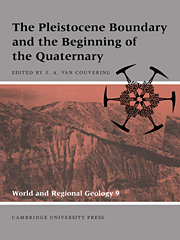Book contents
- Frontmatter
- Contents
- List of contributors
- Preface: the new Pleistocene
- Foreword
- Part I Definition of the base of the Quaternary
- Part II Characterization of the Pleistocene boundary-stratotype
- 2 The Pliocene–Pleistocene boundary-stratotype at Vrica, Italy
- 3 The magnetostratigraphy of the Vrica section, Italy, and its correlation with the Plio–Pleistocene of the Boso Peninsula, Japan
- 4 Comparison of the laminated units at Vrica and deep-sea sapropels from the eastern Mediterranean
- 5 Calcareous nannofossil biochronology and the Pliocene–Pleistocene boundary
- 6 Diatom microfossils from the Vrica section
- Part III The paleontological context of the Pleistocene boundary
- Part IV The Pleistocene boundary in regional sequences
- Index
4 - Comparison of the laminated units at Vrica and deep-sea sapropels from the eastern Mediterranean
Published online by Cambridge University Press: 10 November 2009
- Frontmatter
- Contents
- List of contributors
- Preface: the new Pleistocene
- Foreword
- Part I Definition of the base of the Quaternary
- Part II Characterization of the Pleistocene boundary-stratotype
- 2 The Pliocene–Pleistocene boundary-stratotype at Vrica, Italy
- 3 The magnetostratigraphy of the Vrica section, Italy, and its correlation with the Plio–Pleistocene of the Boso Peninsula, Japan
- 4 Comparison of the laminated units at Vrica and deep-sea sapropels from the eastern Mediterranean
- 5 Calcareous nannofossil biochronology and the Pliocene–Pleistocene boundary
- 6 Diatom microfossils from the Vrica section
- Part III The paleontological context of the Pleistocene boundary
- Part IV The Pleistocene boundary in regional sequences
- Index
Summary
Introduction and background
Sapropels – highly organic, oxygen-reduced layers – in deepwater strata are similar in origin to organic-rich laminite units in upper-slope sediments and are clear manifestations of major changes in the climatic-oceanographic regime of the Mediterranean region. The periodic deposition of organic-rich facies at Vrica may have been related to the intensification of climatic oscillations in the late Pliocene, as seen in the deep-sea record. In this chapter, we review the conditions of sapropelic deposition and the relationship between the upper-slope and deep-sea events in the Ionian Basin during the later Pliocene and early Pleistocene.
Laminated sedimentary units are common features in marine sequences from Miocene to Pleistocene age in the marginal circum-Mediterranean region. For example, laminated sediments have been described from Algeria (Anderson, 1933), Spain (Geel, 1978), Sicily (Ogniben, 1957; Brolsma, 1978; Meulenkamp et al., 1978; McKenzie, Jenkyns, and Bennet, 1979; Gersonde, 1980), southern Italy (Martina et al., 1979), northern Italy (Sturani and Sampo, 1973), Morocco (Bizon, Muller, and Vergnaud-Grazzini, 1979), Cyprus (Bizon et al., 1979), and the Ionian Islands of Greece (Heimann, Just, and Muller, 1979; Thomas, 1980; Spaak, 1983). Many, but not all, of these laminated layers are rich in biogenic silica because of high abundances of diatoms. These diatomaceous laminites are often collectively referred to as “tripoli.”
A number of different mechanisms have been proposed to explain the formation of Neogene laminites in marginal settings. The diatom-rich laminites of Morocco (Bizon et al., 1979) and Sicily (McKenzie et al., 1979; Gersonde, 1980; Van der Zwaan, 1982) have been attributed to increased productivity brought on by increased upwelling of nutrient-rich waters.
- Type
- Chapter
- Information
- Publisher: Cambridge University PressPrint publication year: 1996



